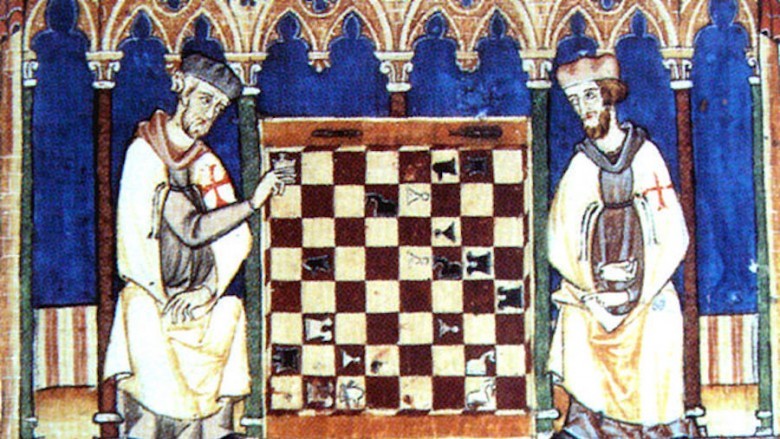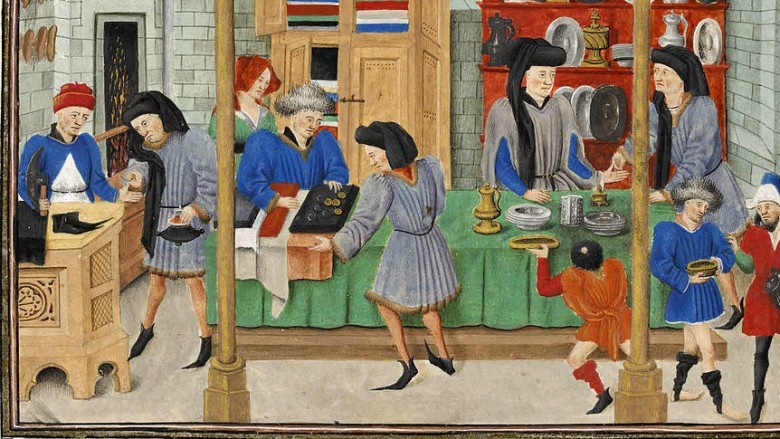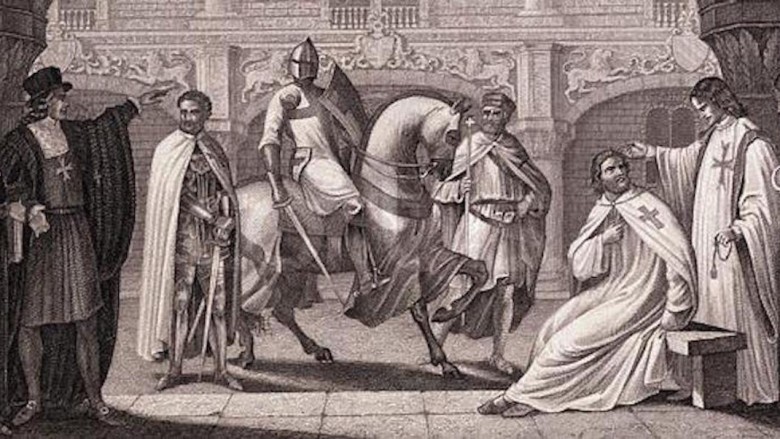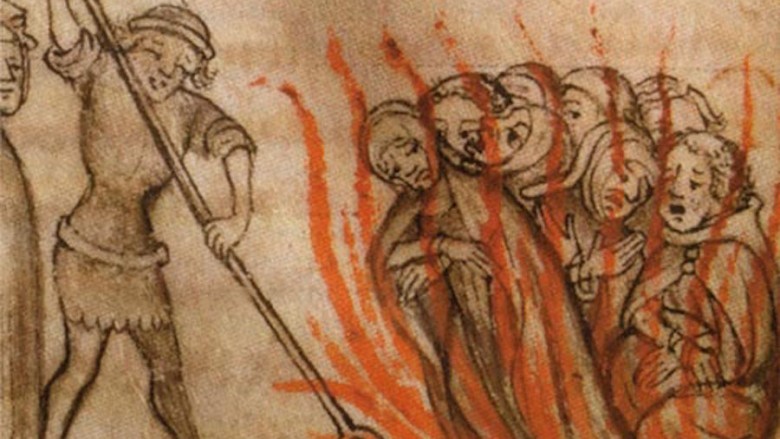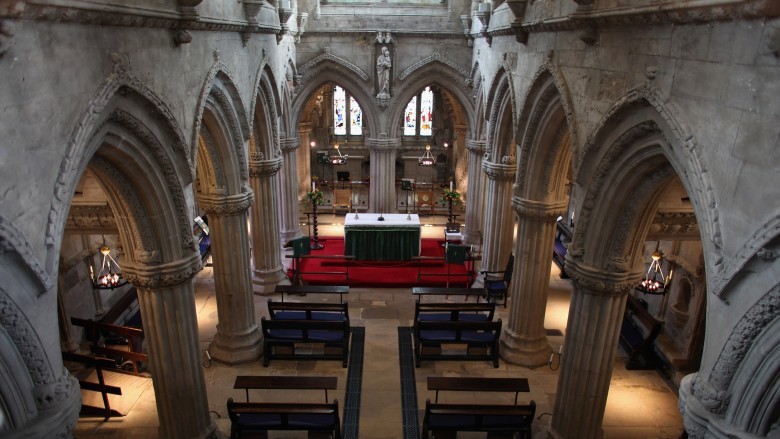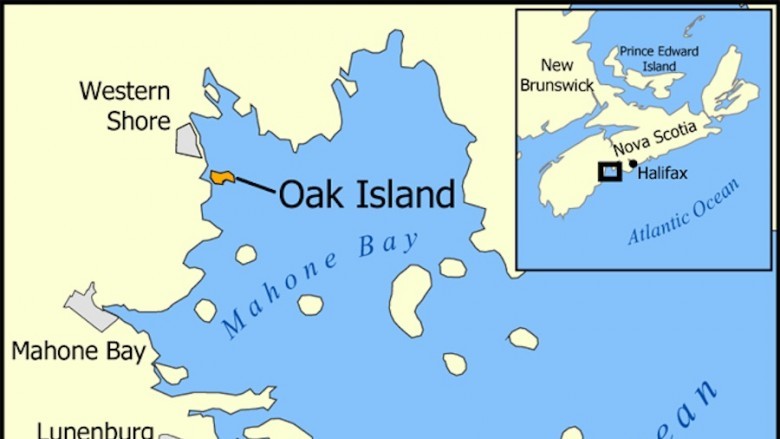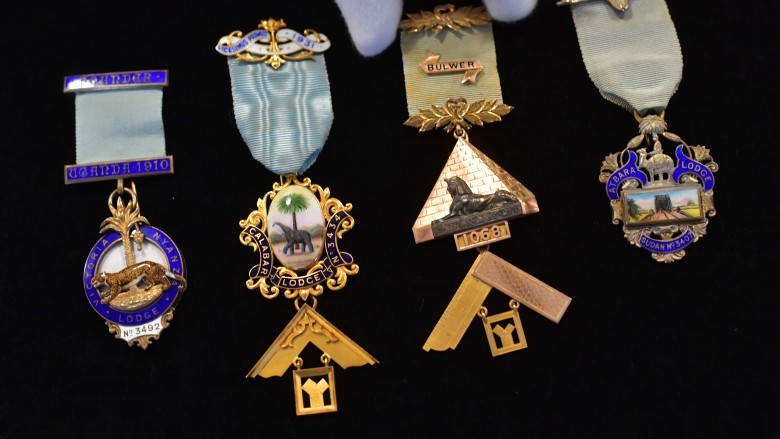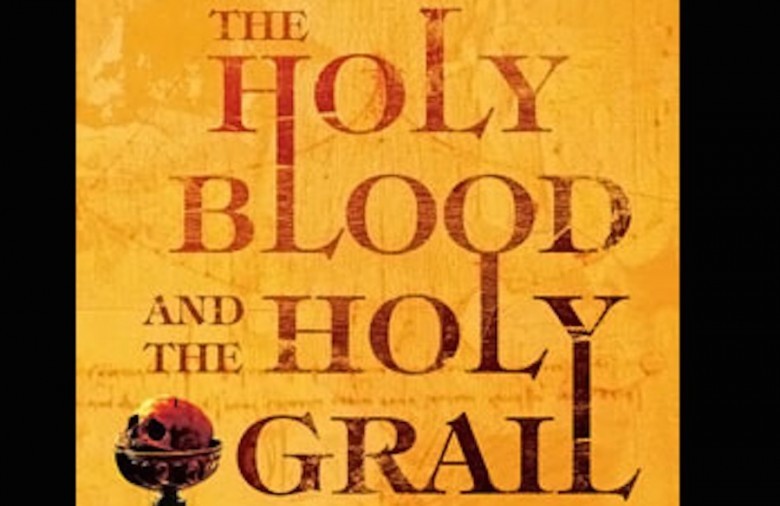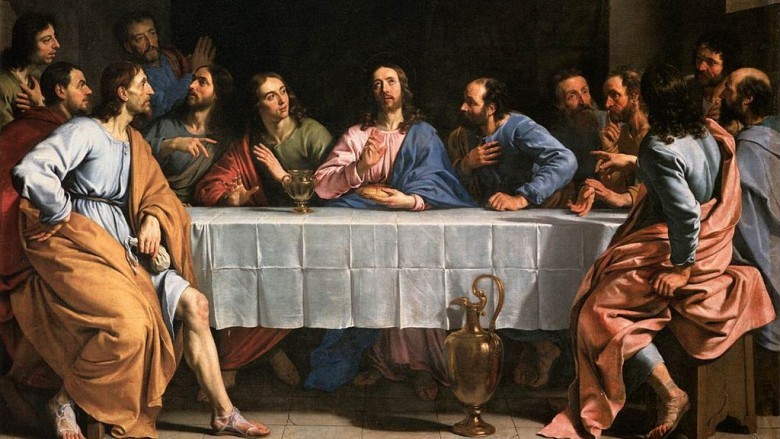The Untold Truth Of The Templars
The Templars (or Knights Templar, as they are often called) were shrouded in mystery. Rumors run rampant about whether they're hiding the Ark of the Covenant or the secret bloodline of Christ. Novelist Dan Brown has made a pretty penny spinning yarns about the cryptic society, but is any of it even true? The Templars have a long history from the Crusades to today, so let's see how much enigmatic business they're really up to.
There are four conflicting stories on how they began
We know the Templars existed, but how exactly they came to be is up for debate. In The Real History Behind the Templars, the author states that the Syrian patriarch, Michael, gave one of the first versions of the Templar story. In 1190, Michael wrote that a man from France traveled to Jerusalem with 30 knights to devote his life to God. But the group of traveling knights was so impressive in battle that the king asked the group to stay in Jerusalem and fight against their enemies. And so, the Templars were born. But Walter Map told a different origin story. According to Map, the Knight Payns traveled from France to Jerusalem, and when he heard that Christians were often attacked by pagans in the city, he decided to stay and fight them off. Payns was a one-man fighting machine, a Chuck Norris for the Lord.
If you asked a monk named Bernard, he'd give you yet another tale. In 1232, he wrote that a group of pilgrims moved to Jerusalem, got tired of just standing around and praying, and formed a group of knights to fight for the Christian way. But the most likely story comes from William, the Archbishop of Tyre. He recalled that Hugh of Payns and Godfrey of St. Omer came to Jerusalem to offer their services to God. Their main tasks were to keep the roads safe and protect the pilgrims from attackers. All versions agree that the Templars first lived on the holy site where Jesus was buried before staying at the palace of King Baldwin II. Whether they started with one dude stomping out pagans or a group of knights that swore themselves to the Lord, either way, the origins aren't very mystical. It was definitely some knights who decided to stay in Jerusalem, still as knights.
They invented paying by check
After settling into Jerusalem, the Templars protected pilgrims on their way in and out of the city. Over time, the group of knights grew to be a powerful military order for the church. Kings from all around Europe gave the knights land and lordships, so they wound up super rich and bought the island of Cyprus.
Though they were valiant fighters known for their bravery, the Templars became just as well known for proto-banking skills. They invented paying by check. That may not sound as exciting as hiding messages in Da Vinci paintings, but it was a pretty big achievement. Pilgrims could give the Templars however much money they'd need in the Holy Land. It would be safer with the group of fearsome knights than a bunch of regular folks walking through the desert. So, the Templars would give the pilgrims a promissory note and make sure all the money would be waiting for them when they got there.
They moved enough gold that the Templars became the most powerful bankers in the land. Again, this is probably not the kind of thing that would go in a summer blockbuster, but it's one of the few things we know for sure about the Templars.
The king of France arrested the Knights Templar to get their money
Thus far, it's well documented that the Templars were a group of valiant knights who made a lot of money. Not really a tale that inspires years of conspiracy theories. But all the rumors began when the king of France arrested every Knight of Templar in 1307 ... on Friday the 13th.
The Templars were going strong till the late 1200s, when Muslims reclaimed the Holy Land. Since the Templars were around to keep Christians safe on their journey to and from the Holy Land, the new Muslim order kind of put them out of a job. But they still had their money, which the king wanted for himself.
King Philip arrested the knights, handed them to the Inquisition, took their land, and accused them all of being heretics. Though there was no evidence of the Templars engaging in devil worshiping, denying God, or peeing on the cross, they were accused of all kinds of heretical actions and painfully interrogated. Some knights ended up confessing to these "sins," but only after being brutally tortured.
This is where the rumors started. People figured the king wouldn't attack the Templars for no reason. The knights must have held some information or treasure he didn't want exposed. But in reality, it seems the king just wanted their money. Calling them heretics was an easy way to get it. At the time, accusing someone of heresy was more like charging them with treason or disobeying the law of the land. Groups like the Cathars, who challenged the Church, had been taken down by a heresy charge in the 13th century, so the Templar charge was nothing new.
The last grand master was burned at the stake
Getting caught up in the Inquisition did not end well for the knights. Those who confessed were able to live in retirement in monasteries, but anyone found to be a relapsed heretic was charged again.
A few years after the original arrest of the Templars, the last Grand Master, Jacques de Molay, and other leaders were called in before a council of the Pope. They were found guilty of relapsed heresy and received life sentences. De Molay argued the ruling and recanted his confession, so his life sentence was lifted. Instead, they burned him at the stake.
In 1312, the Pope officially disbanded the Templars and gave away all their land and money to rivals, putting an end to the knights. Despite the group being destroyed and all their compiled wealth being taken away, lots of people still think the Templars somehow managed to survive.
People think they hid a bunch of religious artifacts in Scotland
After King Philip IV destroyed the knights, there's not much left to the Templar story. But rumors abound.
Some people believe the Templars accumulated important religious artifacts and hid themselves and their treasure and became a secret society. One place they may have hidden their treasure? Rosslyn Chapel in Scotland. Scotland may seem an unlikely choice for a group that mainly stayed between France and holy cities, but many are adamant that relics of the church reside in the chapel built in 1446. Though it's still a functioning chapel, the depths are claimed to hold Jesus's head, the Ark of the Covenant, the lost scrolls of Jerusalem, the Holy Grail, and more.
Some believe after the Templars were targeted, many fled, and some found haven in Scotland. Those exiled knights are rumored to have built Rosslyn Chapel in the image of the Temple of Solomon and then hid their precious relics. The proof? Some of the chapel's carvings may hold secret symbols, and the courtyard holds Templar graves. Still, the carvings appear to be just religious symbols, nothing that's conclusively tied to Templars.
Despite the lack of hard proof, many people insist that Jesus's favorite cup is sitting in Scotland.
Some think the treasure's in Canada
A small Canadian island combines two great mysteries: the Templars and Oak Island's potential treasures.
In 1795, a boy came across a dip in the land of Oak Island and started digging. He hit rock, then planks, then rocks. Later, other people came to dig further, since something was clearly hidden below those purposeful layers. Around 90 feet deep, they found a tablet that when decoded read "forty feet below 2 million pounds are buried." Exciting! Just below the tablet, the workers hit something solid. They figured it was the treasure chest, and instead of immediately digging it up and becoming millionaires, they broke for the night and returned in the morning. Too bad for them, since when they went back, the hole was almost entirely filled with water.
Since then, people have been trying to get to the Oak Island treasure with no results. Because something is so deeply and carefully buried there, people think the Templars may have skipped out on Scotland and buried the Holy Grail at Oak Island. Or the Ark of the Covenant could be down there. Either one. Plus, if you map out the arrangement of six 10-ton stones on the island, it makes a big a cross. It has to be the Templars!
There's no other connection to the Christian group, but flimsy evidence has never deterred a Templar enthusiast.
The Freemasons started the rumor that the Templars started the Freemasons
Some theorists believe the secret Templars started another major secret society—the Freemasons.
As Masons popped up in England around the 18th century, they said they'd discovered the secrets of the Templars. While forming their secret society, they used names, symbols, and the organizational structure of the Knights, seemingly tying the two societies closer together. But just because the Masons used Templar terms doesn't mean they were related to the rumored group. For example, you could start calling yourself Jack Spielberg and go buy a camera, but that doesn't mean you have any connection to Stephen.
The rumor was also helped by early Freemasons commonly telling people they were connected to the Templars. It just sounded cool, and if you're building a secret society, you need to have something exciting to put on your "Join Now" flyers. Despite the rumors, historians agree that by the time the Masons rolled in, the Templars were long gone.
Before The Da Vinci Code, another book popularized the bloodline myth
If you've seen the Da Vinci Code, even if you just watched it to witness Tom Hanks's worst hair, you might remember the theory of Jesus's family. Some believe the Templars' true job is to protect the Holy Grail, but it's not as simple as watching over a cup. The Holy Grail is Jesus's secret bloodline. According to Templar theorists, the French term for Holy Grail translates to "royal blood." So, that must mean that Jesus and Mary Magdalene got married and had kids and the Templars or Sons of Sion were there to protect the documents that proved the marriage and keep safe all the relatives with any trace of Holy blood.
This theory didn't exist until the '80s, but became popular when the book Holy Blood, Holy Grail was released. This "non-fiction" tome is full of spurious facts, but the idea of a secret society (the Sons of Sion) holding onto documents that prove Jesus and Magdalene got hitched caught people's attention.
Just because the story was good doesn't make it true. The authors of Holy Blood, Holy Grail use an array of questionable sources, quote iffy interpretations as facts, and generally disregard the truth. The book at one point literally says that for uncovering this conspiracy ”it is not sufficient to confine oneself exclusively to facts.”
Jesus's bloodline is based on a hoax
Though the authors of Holy Blood, Holy Grail were a pretty flexible with the facts, they did claim to do vast research for their book. It's true that they didn't originate the bloodline theory. That came from French draughtsman Pierre Plantard.
Plantard said he had proof of Jesus's marriage and the Sons of Sion, a later extension of the Templars, were guarding it. Since Plantard claimed to be the head of the Sons of Sion, he'd certainly know.
In 1993, he came to police attention when he wanted to help defend a con artist friend of his. Police were allowed into his home, and they found a variety of suspicious documents, so they called him in for questioning. Quickly, Plantard admitted that the whole Sons of Sion thing was a hoax. In 1956, he'd hired someone to make fake documents and used those to trick people into believing his bloodline myth. The hoax worked pretty well, since it made its way into two bestselling books and he wasn't found out until the '90s.
There are Templars around today, they just aren't that exciting
Last of the rumors is that some people firmly believe the Templars are still around today, existing only in the shadows. For once, there's some truth to this. Templar societies do exist. You could probably go and join them with ease. Would you get to know secrets of the Bible or hide vital religious relics? No. You'd get to do volunteer work around your community and have a cool-sounding club name.
BBC News has compared modern Templars to a Rotary Club. Sure, they get to have a name that implies a mythical backstory, but they're really just there to hang out and provide services for their locality. The modern Templars in the U.K. were formed in the early 1800s and stress that they're living under the spirit of the original Templars but have no actual relationship to them. So, the bad news is you won't get to see Jesus and Magdalene's marriage certificate or find ancient riches and jewels, but you will get to be a part of a civic club and get a title like Webmaster of the Grand Priory.
At the end of the day, the Knights Templar were very religious guys who were good at fighting, protecting people, and making money. Sure, some of them were burned at the stake, but for the Middle Ages, that wasn't terribly scandalous. All the fun stuff about the Templars has been completely disproven, and as much as you might like to find the Holy Grail yourself, the Templars didn't hide it ... or did they?
No. They definitely didn't.

